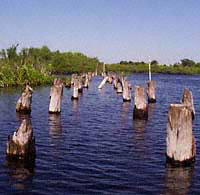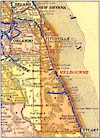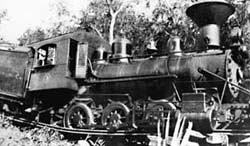The
Union Cypress Railway
 The
old railway trestle is a familiar landmark on the river. You
can see the trestle marching across the river, and out
in the deep cypress you can see huge stumps of downed
trees. Some men we know talk about their dads working
on it years ago...stories of working chest deep in swampwater,
snakes and alligators to build a railway across the marsh. The
old railway trestle is a familiar landmark on the river. You
can see the trestle marching across the river, and out
in the deep cypress you can see huge stumps of downed
trees. Some men we know talk about their dads working
on it years ago...stories of working chest deep in swampwater,
snakes and alligators to build a railway across the marsh.
Other
than watching out not to run into the pilings (if the water
is up high enough you can't see them, you have to know
they are there!), I hadn't given the old trestle much thought.
I've seen it out there forever, but never knew the story
behind it. Then one day the questions started lining up...who
built the railway, and why?...when was it used?...what
was it used for, and why did they quit?...what happened
to all the old rails?

The remains of the 2,850 foot railway trestle
across the St. Johns.
I started
searching the Internet and making phone calls to find the
answers. There was surprisingly little information available...until
I was given the name of a local historian, Ed Vosatka.
Ed was able to give me tons of information - he is quite
an expert on the subject and is writing a book about it.
He also gives talks on the subject to interested groups,
and sets up displays of mill and railway artifacts in local
libraries (contact
Ed for further information on these subjects).
It
turns out that that old railway played a big part in
our local history.  Way
back in the early 1900's Melbourne was almost completely
isolated from the interior of the state. Most available
transportation was up and down the coast, and that only
by rail or steamboat. Cars were just beginning to appear,
but the roads were just sandy, often flooded, wagon trails.
To get to the interior from Melbourne travelers had to
cross a 6-mile wide floodplain and ford the river or use
a hand-operated ferry. The nearest railroad or highway
crossing of the St. Johns was at Orange City Junction,
a long ways away! (Click the map to see a larger image.) Way
back in the early 1900's Melbourne was almost completely
isolated from the interior of the state. Most available
transportation was up and down the coast, and that only
by rail or steamboat. Cars were just beginning to appear,
but the roads were just sandy, often flooded, wagon trails.
To get to the interior from Melbourne travelers had to
cross a 6-mile wide floodplain and ford the river or use
a hand-operated ferry. The nearest railroad or highway
crossing of the St. Johns was at Orange City Junction,
a long ways away! (Click the map to see a larger image.)
In
1912 the Union Cypress Co. built a 3-story, double band-saw
mill in Melbourne. The mill contracted to log all
the hardwood in the Hopkins tract - vast areas of marshland,
grassland, and timber. A stand of virgin cypress called
the Jane Green Swamp provided huge cypress trees.
  
Union Cypress Co. sawmill. |
The mill was the first big employer in Melbourne with
something like 300 men working in the mill and another 200
working out in the timber. It also brought the first electric
power to the city, provided by the mill's power plant. (The
total electric bill for the city of Melbourne averaged about
$175 month.)
Hopkins
was the name of the mill town. They had a post office,
a boarding house, medical facilities, a church, a theatre,
and a park with a swimming pool. Mill workers were paid
in company script or coin and could purchase food and clothing
at the company store (which eventually became Kempfers).
Timber came to the
mill over the 18.5 mile standard gauge railway running
across the St. Johns to Deer Park - the main logging town
where spur lines fanned out into the timber.
The Union Cypress
Railway was in operation for 6 years before the Kissimmee
Highway (US-192) was opened, giving us our first
direct route to the interior. It opened up the prairie
lands for settlement and small railside towns sprang
up. When
the Kissimmee Highway was closed down for repairs in 1923
and 1924 the Union Cypress trains ferried autos eight miles
across the marsh on flat cars for $1.00 each. In February
of 1919 most of downtown Melbourne burnt to the ground,
and in August of that same year so did the mill. Melbourne
was without power for 4 months until electricity could
be obtained from Eau Gallie - a town 5 miles to the north.
(Melbourne and Eau Gallie later merged into one city that
kept the name of Melbourne.)
  
Engine No. 3 of the Union Cypress Railway
wrecked in Deer Park, 1918.
|
The
Union Cypress Co. regrouped and a new fire-proof mill
was begun but never completed. The company shut down
in 1925 after the death of Geo. Hopkins. In 1928
the Foshee Manufacturing Co. took over operations and rebuilt
the railway and the St. Johns trestle, but the depression
cause the mill to shut down. In 1932 the mill, buildings
and railway were all torn down and sold. >>>> More >>>> |


